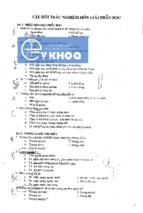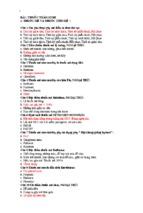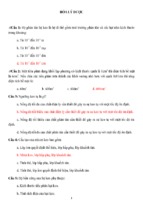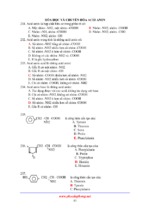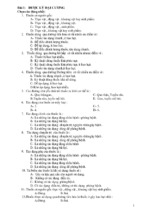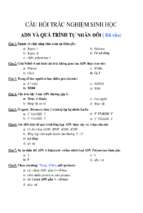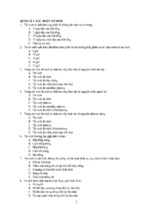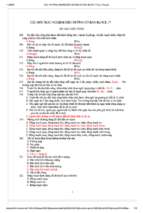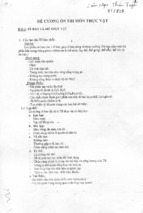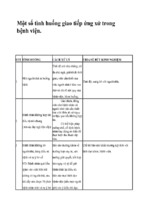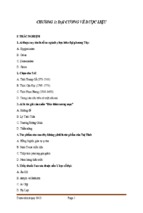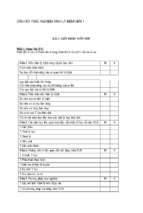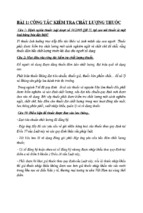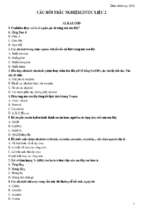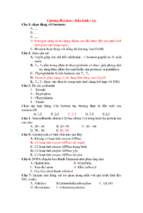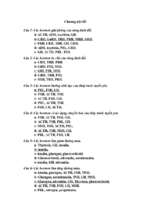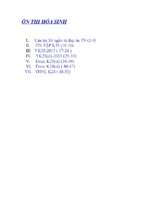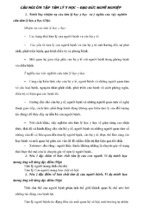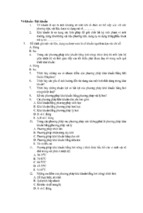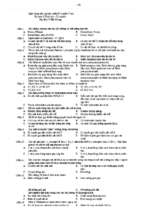UNIT ONE
-
VOCABULARY
pharmacy /'fɑ:mәsi / (n) = pharmaceutics /,fɑ:mә'sju:tiks / (n)dược khoa, khoa bào chế
= drugstore / 'drʌgstɔ:/ nhaø thuoác
pharmacy practice : thöïc haønh döôïc khoa; pharmacist /'fɑ:mәsist / (n)döôïc syõ
multidisciplinary / mʌlti 'disiplinәri / (a) nhieàu moân hoïc
specialize /'spe∫әlaiz / (v)(in) chuyeân veà
medicine /'medsn; 'medisn / (n) → medicinal / mә'disinl / (a)
develop / di'velәp / (v) → development / di'velәpmәnt / (n)
charge /t∫ɑ:dʒ / (v)giao nhieäm vuï, giao vieäc
ensure / in'∫uә / (v) baûo ñaûm
medicate /'medikeit / (v)ñieàu trò baèng thuoác
medication /,medi'kei∫n/ (n) thuoác chöõa beänh, döôïc phaåm; söï cho thuoác
scope /skoup/ (n)phaïm vi
compound / ˈkɒmpaʊnd/ (n) hôïp chaát; compound / ˈkɒmpaʊnd / (v) pha (thuoác)
dispense /dis'pens / (v) phaân phaùt, phaân phoái → dispensation /,dispen'sei∫n / (n)
dispenser /dis'pensә / (n) nhaø baøo cheá, ngöôøi pha thuoác theo ñôn
review / ri'vju:/ (v) xem laïi, xeùt laïi
efficacy /'efikәsi / (n) = efficaciousness /,efi'kei∫әsnis / (n) coù hieäu quaû
provide /prә'vaid/ (v) → provision / prә'viʒn / (n)
providence /'prɔvidәns / (n) söï lo xa, söï döï phoøng
provident /'prɔvidәnt / (a) lo xa, tieát kieäm
expertise /,ekspә'ti:z / (n)
critical /'kritikәl / (a) quyeát ñònh, then choát
clinic /'klinik / (n) phoøng khaùm → clinical /'klinikl / (a)
exceptionally / ik'sep∫әnәli / (adv) caù bieät, khaùc thöôøng
pharmacology /,fɑ:mә'kɑlәdʒi / (n) döôïc lyù
pharmacognosy /fa:mә'kɔgnәsi / (n) döôïc lieäu
pharmaceutical chemistry /,fɑ:mә'sju:tikәl ˈkɛmɪstrɪ/: hoùa döôïc
monitor /'mɔnitә / (v) giaùm saùt
pharmaceutics /ˌfɑːmәˈsjuːtɪks / (n)
physiology /ˌfɪzɪˈɒlәdʒɪ / (n); physiological /ˌfɪzɪәˈlɒdʒɪkәl / (a)
anatomy /әˈnætәmɪ / (n); anatomical /ˌænәˈtɒmɪkәl / (a)
kinetics /kai'netiks / (n) ñoäng löïc hoïc
nephrology /ne'frɔlәdʒi/ (n)
hepatology /hepә'tɔlәdʒi/ (n)
counsel / ˈkaʊnsәl / (v)khuyeân raên, chæ baûo
proper /'prɔpә / (a) ñuùng caùch
adverse /'ædvә:s / (a) baát lôïi, coù haïi
take on: ñaûm nhieäm, nhaän laøm, gaùnh vaùc
pharmaceutical /,fɑ:mә'sju:tikәl / (a) söû duïng thuoác
participate /pɑ:'tisipeit/ (v) tham gia vaøo
optimise /'ɔptimaiz / (v) ñaùnh giaù moät caùch laïc quan, nhìn moät caùch laïc quan
collaboration /kә,læbә'rei∫n / (n) söï coäng taùc
1
-
-
-
physician /fi'zi∫n / (n) baùc syõ
direct / di'rekt; dai'rekt / (v) höôùng tôùi
responsibility /ri,spɔnsә'bilәti / (n) traùch nhieäm
improve / im'pru:v / (v) caûi thieän
outcome /'autkʌm / (n) keát quaû, taùc ñoäng
inquiry / in'kwaiәri/ (n) thaéc maéc
assess /ә'ses / (v) ñaùnh giaù
primary /'praimәri / (a) ban ñaàu
require / ri'kwaiә / (v) ñoøi hoûi
range /reindʒ / (n) lónh vöïc
TERMINOLOGY
-ology: the study of
nephrology means the study of the kidneys
hepatology means the study of the liver
physiology means the study of the functions of the structures of the body
pharmacology means the study of the nature, uses and effects of drugs for medical
purposes
-ologist: specialist
A nephrologist is a physician who specializes in diagnosing and treating diseases
and disorders of the kidneys
A hepatologist a physician who specializes in diagnosing and treating diseases and
disorders of the liver
A physiologist is a scientist who studies physiology
A pharmacist is a licensed specialist who formulates and dispenses prescribed
medications
EXERCISE
Complete with the following words:
a. ensuring
b. derives
c. health sciences
e. the experts
f. provide
g. chemical sciences
i. medications j. cosmetics
k. drug information
m. chemist's
n. positive
o. primary health
d. traditional roles
h. pharmacy practice
l. pharmaceutical drugs
p. modern services
Pharmacy is the health profession that links the __________ with the __________ and
it is charged with __________ the safe and effective use of __________. The word
__________ from the Greek: φάρµακον (pharmakon), meaning "drug" or "medicine".
The scope of __________ includes more __________ such as compounding and
dispensing __________, and it also includes more __________ related to health care,
including clinical services, reviewing medications for safety and efficacy, and providing
__________. Pharmacists, therefore, are __________ on drug therapy and are the
__________ professionals who optimize medication use to __________ patients with
__________ health outcomes.
An establishment in which pharmacy (in the first sense) is practiced is called a
pharmacy, __________ or (in the United States) drug store. US drug stores commonly sell
not only medicines, but also miscellaneous items such as candy (sweets), __________, and
magazines, as well as light refreshments or groceries.
2
UNIT 2
-
VOCABULARY
pharmacology /,fɑ:mә'kɑlәdʒi / (n) döôïc lyù
property /'prɔpәti / (n) ñaëc tính
therapeutics /,θerә'pju:tiks / (n) pheùp chöõa beänh→ therapeutic /,θerә'pju:tik / (a)
medicine /'medsn; 'medisn / (n) → medicinal / mә'disinl / (a); medical /'medikl / (a)
pharmaceutical /,fɑ:mә'sju:tikәl / (n) döôïc phaåm
toxicology /,tɔksi'kɔlәdʒi / (n) khoa ñoäc chaát
therapy /'θerәpi / (n) söï ñieàu trò
apply / ә'plai / (v) öùng duïng → application /,æpli'kei∫n / (n)
antipathogen /ænti'pæθәdʒen / (n) theå choáng gaây beänh
antipathogenic /,ænti'pæθә'dʒenik / (a) choáng söï gaây beänh
capability /,keipә'biliti / (n) khaû naêng
synonym /'sinәnim / (n) töø ñoàng nghóa → synonymous /si'nɔnimәs / (a)ñoàng nghóa
confused /kәn'fju:zd / (a) loän xoän, khoâng roõ raøng
interact /,intәr'ækt / (v) töông taùc
biology /bai'ɔlәdʒi/ (n) → biological /,baiә'lɔdʒikәl / (a)
benefit /'benifit / (n) coù lôïi → benefical /,beni'fi∫әl / (a)
harm / hɑ:m/ (n) taùc haïi → harmful /'hɑ:mful / (a)
toxin /'tɔksin / (n) ñoäc toá → toxic /'tɔksik / (a)
pure /pjuә / (a) thuaàn tuùy
chemical /'kemikl / (n) hoùa chaát
nature /'neit∫ә / (n) → natural /'næt∫rәl / (a)
origin /'ɔridʒin / (n)
mineral /'minәrәl / (n) khoaùng saûn
synthetic / sin'θetik / (a) toång hôïp
subdiscipline /sʌb'disiplin / (n) ngaønh nhoû
clinical /'klinikl / pharmacology: döôïc laâm saøng
neuropharmacology /,njuәrou,fɑ:mә'kɑlәdʒi / (n) döôïc hoïc thaàn kinh
psychopharmacology /saikou,fɑ:mә'kɑlәdʒi / (n) döôïc hoïc taâm lyù
behavior /bi'heivjә / (n)caùch öùng xöû
pharmacoepidemiology /'fa:mәkou,epi,di:mi'ɔlәdʒi / (n)döôïc hoïc dòch teã
posology /pɔ'sɔlәdʒi / (n) moân döôïc löôïng
dose /dous / (v) phaân lieàu
substantially /sәb'stæn∫әli / (adv) veà thöïc chaát, veà caên baûn
pharmacokinetics /,fa:mәkouki'netiks / (n) döôïc ñoäng hoïc
pharmacodynamics /'fa:mәkoudai'næmiks / (n) döôïc löïc hoïc
acronym /'ækrәnim / (n) töø caáu taïo baèng nhöõng chöõ caùi ñaàu cuûa moät nhoùm töø
abbreviation / әˌbriːvɪˈeɪʃәn/ (n)
stand for : laø chöõ vieát taét cuûa; disposition /,dispә'zi∫n / (n) caùch xaép xeáp
convert /kәn'vә:t / (v) bieán ñoåi
mucosa /mj 'kәʊsә /(n)= mucous membrane: maøng nhaày
exert /ig'zә:t / (v) ñöa ra
mucous /'mju:kәs / (a)
3
-
-
intestine /in'testin / (n) → intestinal /in'testinl / (a)
soluble /'sɔljubl / (a) ; solubility /,sɔlju'bilәti / (n) tính tan
stability /stә'bilәti / (n) söï oån ñònh >< instability /,instә'bilәti / (n) khoâng oån ñònh
ability /ә'bilәti/ (n) >< inability /,inә'bilәti / (n)
permeate /'pә:mieit / (v) thaám vaøo
extent / iks'tent/ (n) phaïm vi
administer /әd'ministә / (v) → administration /әd,minis'trei∫n / (n)
desire / di'zaiә / (v) mong muoán, ao öôùc → desirable /di'zaiәrәbl / (a)
intravenously /,intrә'vi:nәsli / (adv)
inhalation /,inhә'lei∫n / (n) >< exhalation /,ekshә'lei∫n / (n)
disperse / dis'pә:s / (v) phaân taùn
disseminate /di'semineit / (v) gieo raéc
metabolism / mә'tæbәlizm/ (n) söï chuyeån hoùa → metabolic /,metә'bɔlik / (a)
metabolite /mә'tæbәlait / (n) chaát chuyeån hoùa
majority / mә'dʒɔriti / (n) phaàn lôùn >< minority /mai'nɔriti / (n)
initial / i'ni∫әl / (a) ban ñaàu, luùc ñaàu
parent /'peәrәnt / (n) nguoàn goác
eliminate / i'limineit/ (v) baøi tieát
remove /ri'mu:v / (v) → removal /ri'mu:vl / (n) söï loaïi boû
via /'vaiә / (adv) theo ñöôøng
urine /'juәrin / (n)
faeces /'fi:si:z / (n) → faecal /'fi:kæl / (a)
complete / kәm'pli:t / (a) troïn veïn
accumulate /ә'kju:mjuleit / (v) tích luõy → accumulation / ә,kju:mju'lei∫n / (n)
adverse /'ædvә:s / (a) coù haïi, baát lôïi → adversely /'ædvә:sli / (adv)
affect /ә'fekt / (v) aûnh höôûng ñeán
normal /'nɔ:mәl / (a) bình thöôøng >< abnormal /æb'nɔ:mәl / (a)
bile /'bail / (n) maät → biliary /'biljәri / (a)
breathe /bri:đ / (v) → breath / breθ / (n)
TERMINOLOGY
-ology: the study of
Neuropharmacology is the study of how drugs affect cellular function in the nervous
system.
Psychopharmacology is the study of drug-induced changes in mood, sensation,
thinking, and behavior.
Pharmacoepidemiology is the study of the use and effects of drugs on large groups of
people.
EXERCISE
I/
Complete with the following words:
a. epidemiology
b. to provide
c. pharmacoepidemiology
d. pharmacology
e. clinical pharmacology
f. patients
To accomplish this study, __________ borrows from both pharmacology and
epidemiology. Thus, pharmacoepidemiology is the bridge between both __________ and
4
__________. Pharmacology is the study of the effect of drugs and __________ is the
study of effect of drugs on clinical humans. Part of the task of clinical pharmacology is
__________ a risk benefit assessment by effects of drugs in __________:
• doing the studies needed to provide an estimate of the probability of beneficial
effects on populations,
• or assessing the probability of adverse effects on populations.
II/
Further reading:
Neuropharmacology is the study of how drugs affect cellular function in the nervous
system. There are two main branches of neuropharmacology: behavioral and molecular.
Behavioral neuropharmacology focuses on the study of how drugs affect human behavior
(neuropsychopharmacology), including the study of how drug dependence and addiction
affect the human brain. Molecular neuropharmacology involves the study of neurons and
their neurochemical interactions, with the overall goal of developing drugs that have
beneficial effects on neurological function. Both of these fields are closely connected, since
both are concerned with the interactions of neurotransmitters, neuropeptides,
neurohormones, neuromodulators, enzymes, second messengers, co-transporters, ion
channels, and receptor proteins in the central and peripheral nervous systems. Studying
these interactions, researchers are developing drugs to treat many different neurological
disorders, including pain, neurodegenerative diseases such as Parkinson's disease and
Alzheimer's disease, psychological disorders, addiction, and many others.
Neuropharmacology did not appear in the scientific field until, in the early part of the
20th century, scientists were able to figure out a basic understanding of the nervous system
and how nerves communicate between one another. Before this discovery, there were drugs,
however, that had been found that demonstrated some type of influence on the nervous
system. In the 1930’s, French scientists began working with a compound called
phenothiazine in the hope of synthesizing a drug that would be able to combat malaria.
Though this drug showed very little hope in the use against malaria infected individuals, it
was found to have sedative effects along with what appeared to be beneficial effects toward
patients with Parkinson’s disease. This black box method, where an investigator would
administer a drug and examine the response without knowing how to relate drug action to
patient response, was the main approach to this field, until, in the late 1940s and early
1950s, scientists were able to identify specific neurotransmitters, such as norepinephrine
(involved in the constriction of blood vessels and the increase in heart rate and blood
pressure), dopamine (the chemical whose shortage is involved in Parkinson’s disease), and
serotonin (soon to be recognized as deeply connected to depression). In the 1950s, scientists
also became better able to measure levels of specific neurochemicals in the body and thus
correlate these levels with behavior. The invention of the voltage clamp in 1949 allowed for
the study of ion channels and the nerve action potential. These two major historical events
in neuropharmacology allowed scientists not only to study how information is transferred
from one neuron to another, but also how a neuron processes this information within itself.
QUESTIONS
1/
2/
3/
4/
5/
6/
What is neuropharmacology?
How many branches of neuropharmacology are there? What are they?
When did neuropharmacology appear in the scientific field?
When did French scientists begin working with a compound called phenothiazine?
When did scientists identify specific neurotransmitters?
Give examples of neurotransmitters
5
UNIT 3
-
VOCABULARY
alter /'ɔ:ltә / (v) thay ñoåi, bieán ñoåi
precise /pri'sais / (a) roõ raøng, chính xaùc
medicine /'medsn; 'medisn / (n) → medicinal / mә'disinl / (a) medical /'medikl / (a)
government /'gʌvnmәnt / (n) chính phuû
regulation /,regju'lei∫n / (n) ñieàu quy ñònh, quy taéc, ñieàu leä
colloquial / kә'loukwiәl / (a) thoâng thöôøng
usage /'ju:zidʒ, 'ju:sidʒ / (n) caùch söû duïng
pharmacology /,fɑ:mә'kɑlәdʒi / (n) döôïc lyù
diagnosis /,daiәg'nousis / (n) pheùp chaån ñoaùn, söï chaån ñoaùn
otherwise /'ʌđәwaiz / (adv) caùch khaùc
enhance /in'hɑ:ns / (v) laøm taêng
well-being /'wel'bi:iη / (n) tình traïng khoûe maïnh
prescribe /pris'kraib / (v) keâ toa → prescription / pris'krip∫n / (n) toa thuoác
duration /djuә'rei∫n / (n) khoaûng thôøi gian
regular /'regjulә / (a) lieân tuïc, thöôøng xuyeân
basis /'beisis / (n) neàn taûng, cô sôû
chronic /'krɔnik / (a) maõn tính >< acute /ә'kju:t / (a) caáp tính
spirit /'spirit / (n) tinh thaàn → spiritual /'spirit∫uәl / (a)
recreation /,rekri'ei∫n / (n) söï giaûi trí → recreational /,rekri'ei∫әnl / (a)
therefore /'đeәfɔ:/ (adv) bôûi vaäy, cho neân
distinguish /dis'tiηgwi∫ / (v)phaân bieät
endogenous / ɛnˈdɒdʒɪnәs / (a) noäi sinh >< exogenous / ɛkˈsɒdʒɪnәs / (a)
biochemical /,baiou'kemikәl / (n)
synthesize /'sinθisaiz / (v) toång hôïp
nature /'neit∫ә / (n) → natural /'næt∫rәl / (a)
blur /blә: / (v) laøm môø
ingest /in'dʒest / (v) aên vaøo
affect /ә'fekt / (v) taùc ñoäng ñeán
psychoactive /'saikouæktiv / (a) taùc ñoäng ñeán trí tueä
experience /iks'piәriәns / (n)
positive /'pɔzәtiv / (a) laïc quan
narcotic /nɑ:'kɔtik / (n)
hallucinogen /hә'lu:sinәdʒen / (n) chaát ma tuùy gaây aûo giaùc
perceive /pә'si:v / (v) nhaän thaáy
benefit /'benifit / (n) coù lôïi → benefical /,beni'fi∫әl / (a)
perception /pә'sep∫n / (n) söï nhaän thöùc
consciousness /'kɔn∫әsnis / (n) yù thöùc
personality /,pә:sә'nælәti / (n) nhaân caùch
behavior /bi'heivjә / (n) hành vi
addict /'ædikt / (n) ngöôøi nghieän → addiction /ә'dik∫n / (n) (to sth) thoùi nghieän
habituate / hә'bit∫ueit/ (n) taïo cho (ai) thaønh thoùi quen → habituation (n)
potential / pә'ten∫l / (n) khaû naêng, tieàm löïc
6
-
legal /'li:gәl / (a) hôïp phaùp >< illegal /i'li:gәl / (a)
alcohol /'ælkәhɔl / (n) → alcoholic /,ælkә'hɔlik / (a)
tobacco /tә'bækou / (n); caffeine /'kæfi:in / (n)
category / ˈkætɪgәrɪ / (n)
cure / kjuә / (v) chöõa beänh
relieve / ri'li:v / (v) laøm dòu ñi, laøm maát ñi
existing / eg'zistiη / (a) ñang toàn taïi
pre-existing /pri:eg'zistiη/ (a) coù tröôùc, toàn taïi tröôùc
symptom /'simptәm / (n) trieäu chöùng
available / ә'veilәbl / (a) saün coù, coù theå duøng ñöôïc
restriction /ri'strik∫n / (n) söï haïn cheá
supervision /,su:pә'viʒn / (n) söï giaùm saùt
distinction / dis'tiηk∫n / (n) söï khaùc bieät
jurisdiction /,dʒuәris'dik∫n / (n) phaïm vi quyeàn löïc phaùp lyù coù theå ñöôïc thöïc thi
typically /'tipikli / (adv) ñieån hình
patent / ˈpeɪtәnt ˈpætәnt/ (v) caáp baèng saùng cheá
exclusive /iks'klu:siv / (a) duy nhaát, ñoäc nhaát
derive /di'raiv / (v) laáy ñöôïc töø
herb / hә:b / (n) thaûo moäc → herbal /'hә:bәl / (a)
expire /iks'paiә / (v) keát thuùc, heát hieäu löïc
generic /dʒi'nerik / (a) name: teân chung >< brand name: teân thöông maïi, bieät döôïc
license /'laisәns / (n) söï cho pheùp
EXERCISE
Complete with the following words:
a. overlap
b. alcohol
e. the use
f. commonly
c. human
g. recreational
d. psychoactive
h. drug abuse
Recreational drug use is ______ of a drug, usually ______, with the intention of
creating or enhancing recreational experience. Such use is controversial, however, often
being considered to be also ______, and it is often illegal. Also, it may ______ with other
uses, such as medicinal (including self medication), performance enhancement, and
entheogenic (spiritual).
Drugs ______ considered capable of recreational use include ______ and tobacco,
and drugs within the scope of the United Nations Single Convention on Narcotic Drugs
and Convention on Psychotropic Substances. The fact that caffeine use may be
considered ______ is often overlooked. Psychopharmacologist Ronald K. Siegel refers to
intoxication as the "fourth drive", arguing that the human instinct to seek mind-altering
substances (psychoactive drugs) has so much force and persistence that it functions like
the ______ desire to satisfy hunger, thirst and the need for shelter.
7
UNIT 4
-
VOCABULARY
consist in: ôû choã
intend /in'tend / (v) coù yù ñònh
antibiotic /,æntibai'ɔtik / (n) thuoác khaùng sinh
prescribe /pris'kraib / (v) keâ toa → prescription / pris'krip∫n / (n) toa thuoác
legal /'li:gәl / (a) hôïp phaùp >< illegal /i'li:gәl / (a)
alcohol /'ælkәhɔl / (n) → alcoholic /,ælkә'hɔlik / (a)
tobacco /tә'bækou / (n)
Cannabis /'kænәbis / (n) ma tuùy laøm töø caây gai daàu
Ecsatasy /'ekstәsi / (n) Chaát gaây höng phaán
Amphetamine /æm'fetәmi:n / (n) thuoác coù taùc duïng kích thích
Paracetamol /ˌpærәˈsiːtәˌmɒl -ˈsɛtә- /
insulin /'insjulin /
ventolin /´ventɔlin / (n)
misuse /mis'ju:z / (n) söï laïm duïng
recommend /,rekә'mend / (v) khuyeân duøng
frequent /'fri:kwәnt / (a) thöôøng xuyeân
interval /'intәvәl / (n) khoaûng caùch (thôùi gian)
remedy /'remәdi / (n) phöông thuoác chöõa beänh
tolerance /'tɔlәrәns / (n) söï lôøn thuoác
psychoactive /'saikouæktiv / (a) taùc ñoäng ñeán trí tueä
require / ri'kwaiә / (v) ñoøi hoûi
achieve /ә't∫i:v / (v) ñaït ñöôïc, daønh ñöôïc
occasional / ә'keiʒәnl / (a) thi thoaûng, ñoâi khi
intoxicated /in'tɔksikeitid / (a) say
genetics /dʒi'netiks / (n) di truyeàn
frequency /'fri:kwәnsi / (n) taàn soá
psychologial /,saikә'lɔdʒikl / (a) thuoäc veà taâm lyù
physiology /,fizi'ɔlәdʒi / (n) → physiological /,fiziә'lɔdʒikl / (a)
addict /'ædikt / (n) ngöôøi nghieän → addiction /ә'dik∫n / (n) (to sth) thoùi nghieän
chronic /'krɔnik / (a) maõn tính >< acute /ә'kju:t / (a) caáp tính
pathology / pә'θɔlәdʒi / (n) beänh lyù hoïc → pathological /,pæθә'lɔdʒikl / (a)
characterize /'kæriktәraiz / (v) coù ñaëc ñieåm
generally /'dʒenәrәli / (adv) thöôøng thöôøng
depressant /di'presәnt / (a) thuoác laøm dòu, thuoác an thaàn
barbiturate / bɑ:'bitjurәt / (n)
tranquilizer /'træηkwilaizә / (n) thuoác an thaàn
opiate /'oupiәt / (n) thuoác coù thuoác phieän
overpowering /,ouvә'pauәriη / (a) khoâng cöôõng laïi ñöôïc
object /'ɔbdʒikt / (n) ñoà vaät, vaät theå
desire / di'zaiә / (v) mong muoán, ao öôùc → desirable /di'zaiәrәbl / (a)
repetitive / ri'petәtiv / (a) coù tính laëp ñi laëp laïi
impulsive /im'pʌlsiv / (a) thoâi thuùc, thuùc ñaåy
8
-
compulsive /kәm'pʌlsiv / (a) eùp buoäc, coù xu höôùng eùp buoäc
cease /si:s / (v) = stop
abstain / әb'stein / (v) (from sth) kieâng, nhòn
withdrawal /wiđ'drɔ:әl/ symptom /'simptәm / : trieäu chöùng ngöng thuoác
restlessness /'restlisnis / (n) söï boàn choàn
irritability /,iritә'biliti / (n) tính caùu baún, tính deã caùu
depression /di'pre∫n / (n) söï buoàn raàu, söï phieàn muoän
disturbance /dis'tә:bәns / (n) söï roái loaïn
convulsion /kәn'vʌl∫n / (n) chöùng co giaät
stimulate /'stimjuleit / (v) kích thích → stimulant /'stimjulәnt / (n) chaát kích thích
increase /in'kri:s / (v) laøm taêng ; /'inkri:s / (n)
maintain / mein'tein / (v) duy trì
alert / ә'lә:t / (a) tænh taùo → alertness / ә'lә:tnis / (n)
counteract /,kauntә'rækt / (v) choáng laïi, khaùng cöï laïi
fatigue /fә'ti:g / (n) söï meät moûi
euphoria / ju:'fɔ:riә / (n) söï khoan khoaùi
majority / mә'dʒɔriti / (n) ña soá >< minority /mai'nɔriti / (n)
jurisdiction /,dʒuәris'dik∫n / (n) phaïm vi quyeàn löïc phaùp lyù coù theå ñöôïc thöïc thi
caffeine /'kæfi:in / (n) ; nicotine /'nikәti:n / (n)
ephedrine /e'fedrin / (n) ; cocaine / kә'kein / (n)
diminish / di'mini∫ / (v) bôùt, giaûm
drowsy /'drauzi / (a) buoàn nguû → drowsiness /'drauzinis / (n) tình traïng buoàn nguû
calm /kɑ:m / (a) bình tónh
relieve / ri'li:v / (v) laøm dòu ñi, laøm maát ñi
symptom /'simptәm / (n) trieäu chöùng
anxious /'æηk∫әs / (a) lo aâu, baên khoaên → anxiety /æη'zaiәti / (n)
insomnia / in'sɔmniә / (n) chöùng maát nguû
benzodiazepine /benzodai'æzip n/
EXERCISE
Complete with the following words:
a. abbreviated b. since
c. available
d. structure e. pronounced
A benzodiazepine (______/ˌbǫnzȅdaɪˈæzɨp n/, sometimes colloquially referred to as a
"benzo", and often ______ in the literature as a "BZD") is a psychoactive drug whose
core chemical ______ is the fusion of a benzene ring and a diazepine ring. The first
benzodiazepine, chlordiazepoxide (Librium), was discovered accidentally by Leo
Sternbach in 1955, and made ______ in 1960 by Hoffmann–La Roche, which has also
marketed diazepam (Valium) ______ 1963.
9
UNIT 5
-
VOCABULARY
tolerance /'tɔlәrәns / (n)
depressant /di'presәnt / (a) thuoác laøm dòu, thuoác an thaàn
classify /'klæsifai / (v) phaân loaïi → classification /,klæsifi'kei∫n / (n)
barbiturate / bɑ:'bitjurәt / (n)
synthetic /sin'θetik / (a) >< natural /'næt∫rәl / (a)
opiate /'oupiәt / (n) thuoác coù thuoác phieän
narcotic /nɑ:'kɔtik / (n)
anesthetic /,ænis'θetik / (n) thuoác gaây meâ, gaây teâ
tranquilizer /'træηkwilaizә / (n) thuoác an thaàn
alcohol /'ælkәhɔl / (n) → alcoholic /,ælkә'hɔlik / (a)
withdrawal /wiđ'drɔ:әl/ symptom /'simptәm /
potentiate /pә'ten∫ieit / (v) laøm cho coù khaû naêng → potentiation /pәtensi'ei∫l / (n)
intentify /in'tensifai / (v) laøm taêng cao leân; intensification (n)
® = Registered Trademark
express / iks'pres / (v) bieåu thò
formula /'fɔ:mjulә / (n) coâng thöùc; formulae (n) [pl]
antihistamine /,ænti'histәmi:n / (n)
additive /'æditiv / (a) coäng höôûng
plus / plʌs / (n) coäng >< minus /'mainәs / (n) tröø
desire / di'zaiә / (v) mong muoán, ao öôùc → desirable /di'zaiәrәbl / (a)
maximum /'mæksimәm / (a) toái ña >< minimum /'minimәm / (a)
response /ri'spɔns / (n) söï ñaùp öùng
represent /,repri'zent / (v) trình baøy
medical representative /'medikl ,repri'zentәtiv / : trình döôïc vieân
per cent / pә'sent /: %
antagonism /æn'tægәnizm / (n) söï phaûn khaùng
opposite /'ɔpәzit / (a)
zero /'ziәrou / = nought / nɔ:t / = nil /nil /
LSD /,el es 'di / = Lysergic acid diethylamide: loaïi ma tuùy gaây ra nhöõng aûo giaùc
Lysergic acid diethylamide / lɪˈsɜːdʒɪk laɪ- ˈæsɪd dai,eθi ‘leimaid /
stimulate /’stimjuleit / (v) kích thích → stimulant /’stimjulәnt / (n) chaát kích thích
counteract /,kauntә’rækt / (v) laøm maát taùc duïng
overdose /’ouvәdous / (n) söû duïng quaù lieàu
hypersensitivity /,haipә:sensi’tiviti / (n) söï quaù nhaïy caûm vôùi thuoác
hypersensitive /,haipә:’sensitiv / (a)
antibiotic /,æntibai’ɔtik / (n) thuoác khaùng sinh
allergy /’ælәdʒi / (n) dò öùng → allergic /ә’lә:dʒik/ (a)
range /reindʒ / (v) ñöôïc xeáp vaøo loaïi
hives / haivz / (n) chöùng phaùt ban
itch / it∫ / (v) ngöùa → itchy /’it∫I / (a)
nausea /’nɔ:sjә / (n) → nauseate /’nɔ:sieit / (v)
shock /∫ɔk / (n)
10
-
expose /iks’pouz / (v) ; to be exposed to the drug: tieáp xuùc vôùi thuoác
adverse /’ædvә:s / (a) baát lôïi, coù haïi
individual /,indi’vidjuәl / (n) caù nhaân, ngöôøi
handle /’hændl / (v) caàm
pharmacist /’fɑ:mәsist / (n)döôïc syõ
veterinarian /,vetәri’neәriәn / (n) baùc syõ thuù y
side effect /’said i’fekt / (n) taùc duïng phuï
harm / hɑ:m/ (n) → harmful /’hɑ:mful / (a)
other than: except
purpose /’pә:pәs / (n) muïc ñích
aplastic/eɪˈplæstɪk / anemia /ә’ni:miә/ (n) thieáu maùu ngöøng phaùt trieån
consume /kәn’sju:m/ (v) söû duïng → consumption /kәn’sʌmp∫n / (n)
Exercise:
1. A company that produces drugs/medicine is called a _______ company.
pharmacy
pharmaceutical
pharmacist
2. If you've had a _______ to these pills in the past I don't recommend you take them again.
nausea
bad feeling
bad reaction
3. Are you _______ taking any other medication?
right now
currently/presently
present/current
4. You can _______your prescription online or by telephone.
re-order
rearrange
react to
5. I just want to make sure there are no _______ with other medication you might be taking.
interaction(s)
prescription(s)
refills
6. In the United States and Canada, there are many _______ pharmacies. You can pick up
your prescription without even getting out of your car!
driving
drive-by
drive-through
7. A negative reaction = An _______ reaction
adverse
awesome
adept
8. _______ medicine is medicine that you can buy without a prescription.
Over-the-counter
On demand
Overpriced
9. Are there any potential _______ ( = problems) from using the medications together?
correlations
complications
collocations
10. Your prescription usually includes your doctor's _______ on how and when to take a
medication.
infractions
complications
instructions
11
Further reading
Aplastic anemia is a condition where bone marrow does not produce sufficient new cells to
replenish blood cells. The condition, per its name, involves both aplasia /әˈpleɪzɪә/ and
anemia. Typically, anemia refers to low red blood cell counts, but aplastic anemia patients
have lower counts of all three blood cell types: red blood cells, white blood cells, and
platelets, termed pancytopenia.
Signs and symptoms
•
•
•
•
Anemia with malaise, pallor and associated symptoms such as palpitations
Thrombocytopenia /ˌθrɒmbәʊˌsaɪtәʊˈpi:nɪә/(low platelet counts), leading to increased
risk of hemorrhage, bruising and petechiae (petechia: /pǺɑti:kǺə/ n pl -chiae /-kǺɕi:/)
Leukopenia /ˌlu:kәʊˈpi:nɪә/(low white blood cell count), leading to increased risk of
infection
Reticulocytopenia (low reticulocyte counts)
Causes
In many cases, the etiology is considered to be idiopathic (cannot be determined), but one
known cause is an autoimmune disorder in which white blood cells attack the bone marrow.
Aplastic anemia is also sometimes associated with exposure to toxins such as benzene
/ˈbǫnzi:n bǫnˈzi:n/, or with the use of certain drugs, including chloramphenicol
/ˌklɔəræmˈfǫnɪˌkɒl/, carbamazepine /ˌkɑəbәˈmæzәˌpi:n/, felbamate, phenytoin / ˌfǫnɪˈtәʊɪn /,
quinine / kwɪˈni:n (US) ˈkwaɪnaɪn/, and phenylbutazone /ˌfi:naɪlˈbju;tәˌzәʊn/. Many drugs are
associated with aplasia mainly according to case reports but at a very low probability. As an
example, chloramphenicol treatment is followed by aplasia in less than 1 in 40,000
treatment courses, and carbamazepine aplasia is even more rare.
Exposure to ionizing radiation from radioactive materials or radiation-producing devices is
also associated with the development of aplastic anemia.
Aplastic anemia is present in up to 2% of patients with acute viral hepatitis.
In some animals aplastic anemia may have other causes. For example, in the ferret (Mustela
putorius furo) aplastic anemia is caused by estrogen toxicity. This is because female ferrets
are induced ovulators, so mating is required to bring the female out of heat. Intact females,
if not mated, will remain in heat, and after some time the high levels of estrogen will cause
the bone marrow to stop producing red blood cells.
Short-lived aplastic anemia can also be a result of parvovirus infection. In humans the P
antigen (also known as globoside) is the cellular receptor for parvovirus B19 virus that
causes erythema /ǫrɪˈθi:mә/ infectiosum (fifth disease) in children. Parvovirus causes
complete cessation of red blood cell production. In most cases, this goes unnoticed, as red
blood cells live for up to 180 days, and the drop in production does not significantly affect
the total number of circulating red blood cells. In people with conditions where the cells die
early (such as sickle cell disease), however, parvovirus infection can lead to severe anemia.
12
UNIT 6
-
VOCABULARY
develop /di'velәp / (v) → development /di'velәpmәnt / (n)
vital /'vaitl / (a) quan troïng
concern /kәn'sә:n / (n) moái quan taâm
medicine /'medsn; 'medisn / (n) → medicinal / mә'disinl / (a)
economy / i:'kɔnәmi / (n) → economical /,i:kә'nɔmikәl / (a)
politics /'pɔlitiks / (n) → political /pә'litikl/ (a)
implicate /'implikeit / (v) nguï yù, haøm yù, aùm chæ → implication /,impli'kei∫n / (n)
government /'gʌvnmәnt / (n) chính phuû
regulate /'regjuleit / (v) quy ñònh
manufacture /mænju'fækt∫ә / (v), (n)
consume /kәn'sju:m/ (v) söû duïng → consumer /kәn'sju:mә / (n) ngöôøi tieâu duøng
prevent /pri'vent / (v)
abuse /ә'bju:s / (n) söï laïm duïng
pharmaceutical /,fɑ:mә'sju:tikәl / (n) döôïc phaåm
Europe /'juәrәp / (n) → European /,juәrә'pi:әn / (a)
union /'ju:niәn / (n) lieân minh
evaluate /i'væljueit / (v) ñaùnh giaù → evaluation /i,vælju'ei∫n / (n)
agency /'eidʒәnsi / (n) cô quan, sôû
establish /is'tæbli∫ / (v) laäp, thaønh laäp, thieát laäp
passage /'pæsidʒ / (n) söï thoâng qua
Federal /'fedәrәl / (a) (thuoäc) lieân bang
Act /ækt / (n) ñaïo luaät
responsible / ri'spɔnsәbl / (a) traùch nhieäm → responsibility /ri,spɔnsә'bilәti / (n)
diet /'daiәt / (n) → dietary /'daiәtәri / (a)
supplement /'sʌplimәnt / (n) phaàn boå xung
vaccine /'væksi:n / (n)
device / di'vais / (n) duïng cuï
radiate /'reidieit / (v) → radiation /,reidi'ei∫n / (n) phoùng xaï
emit /i'mit / (v) phaùt ra
veterinarian /,vetәri'neәriәn / (n) baùc syõ thuù y; veterinary /'vetrinri; 'vetәrineri / (a)
cosmetic / kɔz'metik / (n) myõ phaåm
guideline /'gaidlain / (n) nguyeân taéc chæ ñaïo, ñöôøng loái chæ ñaïo
require / ri'kwaiә / (v) ñoøi hoûi
fufill /ful'fil / (v) = fulfil / ful'fil / (v) ñaùp öùng
standard /'stændәd / (n) tieâu chuaån
seek / si:k / (v) tìm kieám
approve / ә'pru:v / (v) chaáp thuaän → approval /ә'pru:vәl / (n)
criterion / krai'tiәriәn / (n) [sing] tieâu chuaån → criteria /krai'tiәriә/ [pl]
extensive / iks'tensiv / (a) coù phaïm vi roäng
currently /'kʌrәntli / (adv) hieän thôøi, hieän nay
phase / feiz / (n) giai ñoaïn, thôøi kyø
clinical /'klinikl / (a) (thuoäc) laâm saøng
13
-
trial /'traiәl / (n) phöông phaùp thöû , pheùp thöû
individual /,indi'vidjuәl / (n) caù nhaân, ngöôøi
obtain / әb'tein / (v) ñaït ñöôïc, thu ñöôïc, daønh ñöôïc
include / in'klu:d / (v) bao goàm
species /'spi:∫i:z / (n) loaøi
effective / i'fektiv / (a) coù hieäu quaû → effectiveness /i'fektivnis / (n)
toxicity / tɔk'sisәti / (n) ñaëc tính ñoäc, ñoä ñoäc
dosage /'dousidʒ / (n) lieàu löôïng
intend /in'tend / (v) döï ñònh, ñònh
range / reindʒ / (n) phaïm vi
therapeutics /,θerә'pju:tiks / (n) pheùp chöõa beänh→ therapeutic /,θerә'pju:tik / (a)
effect / i'fekt / (n) hieäu quaû
desire / di'zaiә / (v) mong muoán, ao öôùc → desirable /di'zaiәrәbl / (a)
outcome /'autkʌm / (n) keát quaû
monitor /'mɔnitә / (v) giaùm saùt
determine / di'tә:min / (v) xaùc ñònh
base / beis / (v) boá trí: Where are you based now? Baây giôø anh ñöôïc boá trí ôû ñaâu?
science /'saiәns / (n) → scientific /,saiәn'tifik / (a)
whereby / weә'bai / (adv) nhôø ñoù, bôûi ñoù
basis /'beisis / (n) neàn taûng, cô sôû
Commission / kә'mi∫n / (n) hoäi ñoàng
issue /'isju:/ (v) ñöa ra, phaùt haønh
single /'siηgl / (a) rieâng reõ, töøng caùi moät
marketing /'ma:kitiη / (n) söï tieáp thò
authorisation /,ɔ:θәrai'zei∫n / (n) giaáy pheùp, söï cho pheùp, söï caáp pheùp
produce / prә'dju:s; prә'du:s / (v) ; /'prɔdju:s; 'prɔdu:s / (n) → product /'prɔdәkt / (n)
mission /'mi∫n / (n) söù maänh, nhieäm vuï
promote /prә'mout / (v) xuùc tieán, ñaåy maïnh
public health /'pʌblik'helθ / (n) y teá
contribute / kәn'tribju:t / (v) ñoùng goùp, goùp phaàn
availability / ә,veilә'biliti / (n) söï coù giaù trò
stimulate /'stimjuleit / (v) kích thích
develop /di'velәp / (v) → development / di'velәpmәnt / (n)
innovative /'inouveitiv / (a) coù tính chaát ñoåi môùi, coù tính chaát saùng kieán
assist / ә'sist / (v) giuùp ñôõ
procedure / prә'si:dʒә / (n) thuû tuïc
efficacy /'efikәsi / (n) = efficaciousness /,efi'kei∫әsnis / (n) coù hieäu quaû
prior /'praiә / (prep) tröôùc khi
constantly /'kɔnstәntli / (adv) luoân luoân, lieân tuïc
once /wʌns/ (conjunction) khi maø, ngay khi, moät khi
basic /'beisik / (a) cô baûn, caên baûn
legislate /'ledʒisleit / (v) laäp phaùp → legislation /,ledʒis'lei∫n / (n)
adapt / ә'dæpt / (v) laøm thích öùng
progress /'prougres / (n) söï tieán boä ; /prә'gres/ (v) tieán tôùi, tieán boä
14
-
competition /,kɔmpi'ti∫n / (n) söï caïnh tranh
prospect /'prɔspekt / (n) trieån voïng ; / prә'spekt/ (v) thaêm doø
therapy /'θerәpi / (n) lieäu phaùp
enlarge /in'lɑ:dʒ/ (v) → enlargement /in'lɑ:dʒmәnt/ (n) phaàn môû roäng
access /'ækses / (v) tieáp caän vôùi
grant / grɑ:nt / (v) ñoàng yù cho, cho pheùp
centralise /'sentrәlaiz / (v) taäp trung
consequently /'kɔnsikwәntli / (adv) do ñoù, vì vaäy, bôûi vaäy
essential / i'sen∫әl / (a) chuû yeáu
Further reading:
Lysergic acid diethylamide, abbreviated LSD or LSD-25, also known as lysergide and
colloquially as acid, is a semisynthetic psychedelic drug of the ergoline family, well known
for its psychological effects which can include altered thinking processes, closed and open eye
visuals, synaesthesia, an altered sense of time and spiritual experiences, as well as for its key
role in 1960s counterculture. It is used mainly as an entheogen, recreational drug, and as an
agent in psychedelic therapy. LSD is non-addictive, is not known to cause brain damage, and
has extremely low toxicity relative to dose.
LSD was first synthesized by Albert Hofmann in 1938 from ergotamine, a chemical
derived by Arthur Stoll from ergot, a grain fungus that typically grows on rye. The short form
"LSD" comes from its early code name LSD-25, which is an abbreviation for the German
"Lysergsäure-diethylamid" followed by a sequential number. LSD is sensitive to oxygen,
ultraviolet light, and chlorine, especially in solution, though its potency may last for years if it
is stored away from light and moisture at low temperature. In pure form it is a colorless,
odorless, and mildly bitter solid. LSD is typically delivered orally, usually on a substrate such
as absorbent blotter paper, a sugar cube, or gelatin. In its liquid form, it can also be
administered by intramuscular or intravenous injection. LSD is very potent, with 20–30 µg
(micrograms) being the threshold dose.
Introduced by Sandoz Laboratories, with trade-name Delysid, as a drug with various
psychiatric uses in 1947, LSD quickly became a therapeutic agent that appeared to show great
promise. In the 1950s the CIA thought it might be applicable to mind control and chemical
warfare; the agency's MKULTRA research program propagated the drug among young
servicemen and students. The subsequent recreational use of the drug by youth culture in the
Western world during the 1960s led to a political firestorm that resulted in its prohibition.
Currently, a number of organizations—including the Beckley Foundation, MAPS, Heffter
Research Institute and the Albert Hofmann Foundation—exist to fund, encourage and
coordinate research into the medicinal and spiritual uses of LSD and related psychedelics.
1/ What is LSD?
2/ When was LSD first synthesized?
3/ What is ergotamine?
4/ How is LSD administered?
5/ What is Delysid?
6/ What does the CIA think of LSD?
15
UNIT 7
Vocabulary
medicine / ˈmɛdɪsɪn ˈmɛdsɪn / (n); medicinal / mɛˈdɪsɪnәl / (a); medical /ˈmɛdɪkәl/ (a)
powerful /ˈpaʊәfʊl/ (n)
substance /ˈsʌbstәns/ (n)
dangerous /ˈdeɪndʒәrәs/ (a)
pharmacy /'fɑ:mәsi / (n) = drugstore / 'drʌgstɔ:/ nhaø thuoác
supermarket / ˈsuːpәˌmɑːkɪt / (n)
proper / ˈprɒpә / (a) properly / ˈprɒpәli / (adv)
overcome /ˌәʊvәˈkʌm / (v)
percent / pәˈsɛnt / (adv); percentage / pәˈsɛntɪdʒ / (n)
prescribe /prɪˈskraɪb / (v); prescription /prɪˈskrɪpʃәn / (n)
different /ˈdɪfәrәnt ˈdɪfrәnt / (a); difference /ˈdɪfәrәns ˈdɪfrәns / (n)
chemistry /ˈkɛmɪstrɪ / (n); chemical /ˈkɛmɪkәl / (a)
pharmacist /ˈfɑːmәsɪst / (n)
symptom / ˈsɪmptәm / (n)
diet / ˈdaɪәt / (n); dietary /ˈdaɪәtәrɪ -trɪ / (a)
supplement /ˈsʌplɪmәnt / (n) phần bổ sung
allergy /ˈælәdʒɪ / (n); allergic / әˈlɜːdʒɪk / (a)
sensitive /ˈsɛnsɪtɪv/ (a) ; sensitivity /ˌsɛnsәˈtɪvәtɪ / (n)
exercise /ˈɛksәˌsaɪz/ (n)
weight /weɪt/ (n); to lose weight >< to gain/ put on weight
pregnant /ˈprɛgnәnt/ (a); pregnancy /ˈprɛgnәnsɪ/ (n)
breastfeed /ˈbrestˌfiːd/ (v) >< bottlefeed /ˈbɔtl ˌfiːd/ (v)
instruct /ɪnˈstrʌkt/ (v) ; instruction /ɪnˈstrʌkʃәn/ (n)
label / ˈleɪbәl/ (n): on the label
rough /rʌf/ (a)
absorb /әbˈsɔːb -ˈzɔːb/ (v); absorption /әbˈsɔːpʃәn -ˈzɔːp-/ (n)
strong /strɒŋ/ (a); strength /strɛŋθ/ (n)
at full strength = with all the best effects
a range of beers with different strengths (= with different amounts of alcohol in them)
He pushed against the rock with all his strength
digest /dɪˈdʒɛst daɪ-/ (v); digestive /dɪˈdʒɛstɪv daɪ-/ (a); digestion /dɪˈdʒɛstʃәn daɪ-/ (n)
effect /ɪˈfɛkt/ (n); effective /ɪˈfɛktɪv/ (a)
upset /ʌpˈsɛt/ (v); irritate /ˈɪrɪˌteɪt/ (v)
stomach /ˈstʌmәk/ (n); stomachache /ˈstʌmәkˌeɪk/ (n)
minimize /ˈmɪnɪˌmaɪz/ (v)
prevent sth/sb from doing sth
substitute /ˈsʌbstɪˌtjuːt/ (v)
swallow /'swɔl / (v)
chew /tʃuː / (v) ; chewing gum /tʃuːiɳgʌm / (n)
feature /ˈfiːtʃә/ (n)
germ /dʒɜːm/ (n)
resistant /rɪˈzɪstәnt/ (a); resistance /rɪˈzɪstәns/ (n)
16
Unit 8
Vocabulary
customer /ˈkʌstәmә/ (n)
medicine / ˈmɛdɪsɪn ˈmɛdsɪn / (n); medicinal / mɛˈdɪsɪnәl / (a); medical /ˈmɛdɪkәl/ (a)
include / ɪnˈkluːd/ (v)
alternative /ɔːlˈtɜːnәtɪv/ (n)
side effect /'said i'fekt / (n)
store /stɔː / (v) cất giữ; storage /ˈstɔːrɪdʒ / (n)
continue /kәnˈtɪnjuː / (v)
affect /әˈfɛkt/ (v)
proper / ˈprɒpә / (a) properly / ˈprɒpәli / (adv)
pleasant / ˈplɛzәnt / (a) >< unpleasant /ʌnˈplɛzәnt /(a)
prescribe /prɪˈskraɪb / (v); prescription /prɪˈskrɪpʃәn / (n)
recommend /ˌrɛkәˈmɛnd/ (v) khuyên dùng
double / ˈdʌbәl / (v) To be twice as much as
overdose / ˈәʊvәˌdәʊs / (n) an excessive dose; / әʊvәˈdәʊs / (v) to take an excessive dose or
give an excessive dose to.; over dosage / ˈәʊvә ˈdәʊsɪdʒ / (n)
excessive / ɪkˈsɛsɪv / (a) dư thừa, quá mức
people / ˈpiːpәl / (n) ; pupil / ˈpjuːpl / (n)
symptom / ˈsɪmptәm / (n) triệu chứng
similar / ˈsɪmɪlә / (a) ; similarity / ˌsɪmәˈlærɪti / (n)
pharmacist / ˈfɑːmәsɪst / (n)
classify / ˈklæsɪˌfaɪ / (v) ; classification / ˌklæsɪfɪˈkeɪʃәn /(n)
actually / ˈæktʃʊәlɪ / (adv)
medication / ˌmɛdɪˈkeɪʃәn / (n)
present / prɪˈzɛnt / (v) trình bày, bộc lộ ; /ˈprɛzәnt / (n) a gift
nature /ˈneɪtʃә/ (n); natural /ˈnætʃrәl -tʃәrәl/ (a)
course / kɔːs / (n) tiến trình, quá trình diễn biến
complicated /ˈkɒmplɪˌkeɪtɪd/ (a) phức tạp >< uncomplicated /ʌnˈkɒmplɪˌkeɪtɪd/ (a) đơn giản
cure / kjʊә / (v) chữa cho khỏi bệnh
sore throat / sɔː θrәʊt / (n)
treat / triːt / (v) điều trị ; treatment / ˈtriːtmәnt / (n)
usually / ˈjuːʒʊәlɪ / (adv)
virus / ˈvaɪrәs / (n); bacterium /bækˈtɪәrɪәm /(n)[sing], bacteria / bækˈtɪәrɪә / [pl]
bactericide / bækˈtɪәrɪˌsaɪd / (n) thuốc diệt khuẩn
bactericidal / bæktɪәrɪˈsaɪdәl / (a)
bacteriostasis / bækˌtɪәrɪәʊˈsteɪsɪs -ˈstæsɪs / (n) sự kìm khuẩn;
bacteriostatic /bækˌtɪərɪəʊˈstætɪk/ adj
antibiotic / ˌæntɪbaɪˈɒtɪk / (n)
cough / kɒf / (n, v);
secrete / siˈkriːt/ (v); secretion / sɪˈkriːʃәn / (n)
distressing / dɪˈstrɛsɪŋ / (a) làm cho khó chịu
remedy / ˈrɛmɪdɪ / (n) any drug or agent that cures a disease or controls its symptoms
instill / ɪnˈstɪl / US instill (v) nhỏ, rỏ (mắt, mũi, tai)
occasional / әˈkeɪʒәnәl / (a)
relieve / rɪˈliːv / (v) ; relief / rɪˈliːf / (n)
17
-
anti-anxiety /ˌæntɪæŋˈzaɪәtɪ/ (n)
allergy /ˈælәdʒɪ / (n); allergic / әˈlɜːdʒɪk / (a)
rhinitis /raɪˈnaɪtɪs/ (n) viêm mũi
adult / ˈædʌlt әˈdʌlt / (n)
abdomen / ˈæbdәmәn æbˈdәʊ- / (n) bụng ; abdominal / æbˈdɒmәnl/ (a)
headache / ˈhɛdˌeɪk / (n)
origin / ˈɒrɪdʒɪn / (n) ; original / әˈrɪdʒɪnәl/(a)
package / ˈpækɪdʒ/ (n)
moisture / ˈmɔɪstʃә / (n) hơi ẩm
resume / rɪˈzjuːm / (v) bắt đầu lại, tiếp tục lại
schedule /ˈʃɛdjuːl (also, esp US) ˈskɛdʒʊәl/ (n)
steroid / ˈstɪәrɔɪd ˈstɛr- / (n); steroidal / ˈstɛrɔɪdәl / (a)
non-steroid / nɔn ˈstɪәrɔɪd, nɔnˈstɛr- / (n); non-steroidal / nɔn ˈstɛrɔɪdәl / (a)
anti-inflammatory / ˌænti ɪnˈflæmәˌtɔri, -ˌtoʊri, ˌæntaɪ- / (a)
bad / worse /wɜːs / / worst /wɜːst / >< good / better / best
generic / dʒɪˈnɛrɪk / (a)
analgesic /ˌænәlˈdʒiːzɪk -sɪk / (a) giảm đau; antipyretic / ˌæntɪpaɪˈrɛtɪk / (a) hạ nhiệt
SYNONYMS
Consist of: Comprise / make up / constitute / be composed of / be comprised of / compose
All these words mean to be formed from the things or people mentioned, or to be the parts that
form sth.
Consist of sb/sth to be formed from the things, people or activities mentioned: Their diet
consists largely of vegetables.
Comprise (rather formal) to be formed from the things or people mentioned: The collection
comprises 327 paintings.
NOTE
Comprise can also be used to refer to the parts or members of sth: Older people comprise a
large proportion of those living in poverty. However, this is less frequent.
Make up sth (rather informal) to be the parts or people that form sth: Women make up 56%
of the student numbers.
Constitute to be the parts or people that form sth: People under the age of 40 constitute the
majority of the labour force.
Be composed of sb/sth (rather formal) to be formed from the things or people mentioned:
Around 15% of our diet is composed of protein.
Be comprised of sb/sth to be formed from the things or people mentioned: The committee is
comprised of representatives from both the public and private sectors.
NOTE
Some people consider this usage incorrect, and prefer to use the active verb comprise.
Compose (formal) to be the parts of people that form sth: Christians compose around 2.5%
of the country's population.
Which word?
Consist of sb/sth is the most general of these words and the only one that can be used for
activities with the -ing form of a verb: My work at that time just consisted of typing letters.
The other main difference is between those verbs that take the whole as the subject and the
parts as the object: The group consists of / comprises / is made up of / is composed of / is
comprised of ten people. and those that take the parts as the subject and the whole as the
18
object: Ten people make up / constitute / comprise / compose the group. It is not correct to
use ‘comprises of’ or ‘is composed by / from‘.
Unit 9
Vocabulary and structure:
tip /tip/ (n) lời khuyên
medicine / ˈmɛdɪsɪn ˈmɛdsɪn / (n); medicinal / mɛˈdɪsɪnәl / (a); medical /ˈmɛdɪkәl/ (a)
proper / ˈprɒpә / (a) properly / ˈprɒpәli / (adv)
guideline /ˈgaɪdˌlaɪn/ (n) nguyên tắc chỉ đạo
bathroom /ˈbɑːθˌruːm -ˌrʊm/ (n)
kitchen sink /ˈkɪtʃɪn sɪŋk /(n) a sink in a kitchen for washing dishes, vegetables, etc.
damp /dæmp/ (a) = moist /mɔɪst/ (a); moisture /ˈmɔɪstʃә/ (n)
refrigerate /rɪˈfrɪdʒәˌreɪt/ (v) làm lạnh; refrigerator /rɪˈfrɪdʒәˌreɪtә/ (n)
fridge /frɪdʒ/ (n); fridge-freezer / frɪdʒ ˈfriːzә/
outdated /ˌaʊtˈdeɪtɪd / (a) = expired /ɪkˈspaɪәd / (a)
luggage /ˈlʌgɪdʒ / (n) = baggage /ˈbægɪdʒ / (n) [US]
adequate /ˈædɪkwɪt / (a) = sufficient /sәˈfɪʃәnt / (a) = enough /ɪˈnʌf / (a)
inadequate /ɪnˈædɪkwɪt / (a) = insufficient /ˌɪnsәˈfɪʃәnt / (a) = deficient /dɪˈfɪʃәnt / (a)
available /әˈveɪlәbәl/ (a)
prescribe /prɪˈskraɪb / (v); prescription /prɪˈskrɪpʃәn / (n)
side effect /'said i'fekt / (n)
intended /ɪnˈtɛndɪd/ (a) >< unwanted /ʌnˈwɒntɪd/ (a)
possible /ˈpɒsɪbәl/ (a) ; possibly /ˈpɒsɪblɪ/ (adv) ; possibility /ˌpɒsɪˈbɪlɪtɪ/ (n)
therapy /ˈθɛrәpɪ/ (n)
effect /ɪˈfɛkt/ (n); effective /ɪˈfɛktɪv/ (a)
right /raɪt/ (a) >< wrong /rɒŋ/ (a)
actually /ˈæktʃʊәlɪ/ (adv) really
bad / bæd / / worse / wɜːs / / worst / wɜːst />< good / gʊd / / better / ˈbɛtә / / best / bɛst /
versus /ˈvɜːsәs/ (prep) đối với
come in: thấy ở (dạng)
generally /ˈdʒɛnrәlɪ/ (adv) usually
ingredient /ɪnˈgriːdɪәnt/ (n) thành phần
amount /әˈmaʊnt/ (n) số lượng
sensitive /ˈsɛnsɪtɪv/ (a) ; sensitivity /ˌsɛnsәˈtɪvәtɪ / (n)
sunburn /ˈsʌnˌbɜːn/ (n) ; sunburnt /ˈsʌnˌbɜːnt/ (a) = sunburned / ˈsʌnˌbɜːnd / (a)
rash / ræ∫/ (n) chứng phát ban
in case (something happens): in the event that something takes place.
E.g.: She carries an umbrella in case it rains.
I have some aspirin in my office in case I get a headache.
He keeps a fire extinguisher in his car, just in case.
19
UNIT 10
-
-
VOCABULARY
medicine /'medsn; 'medisn / (n) → medicinal / mә'disinl / (a)
prescribe /pris'kraib / (v) keâ toa → prescription / pris'krip∫n / (n) toa thuoác
relieve /ri'li:v / (v) pain: giaûm ñau
pain-killer /'pein,kilә / (n) = pain reliever / pein ri'li:vә /: thuoác giaûm ñau
antihistamine /,ænti'histәmi:n / (n)
decongestant /'di:kәn'dʒestәnt / (n) thuoác laøm thoâng muõi, choáng ngheït muõi
cough medicine /kɒf'medisn / (n)
headache / ˈhɛdˌeɪk / (n)
muscle ache / ˈmʌsəlˌeɪk / (n) ≈ myalgia / maɪˈældʒɪә / (n)
arthritis / ɑ:'θraitis / (n) chöùng vieâm khôùp
surgery /'sә:dʒәri / (n) phaãu thuaät
injure /'indʒә / (v) → injury / ˈɪndʒәrɪ / (n)
backache / ˈbækˌeɪk / (n) đau lưng = back pain / ˈbækˌpeɪn / (n)
advantage /әd'vɑ:ntidʒ / (n) >< disadvantage /,disәd'vɑ:ntidʒ / (n) = risk
respond / ri'spɔnd / (v) phaûn öùng laïi → response /ri'spɔns/ (n)
steroid /'sterɔid,'stiәrɔid /(n) → steroidal /'sterɔidәl /(a) >< nonsteroidal /,nɔn'sterɔidәl/ (a)
anti-inflammatory /,æntiin'flæmәtәri / (a) khaùng vieâm, choáng vieâm
acetaminophen /әˌsi:tәˈmɪnȅfɪn/
prostaglandin /ˌprɒstәˈglændɪn / (n)
chemical /'kemikl / (n)
irritate /'iriteit / (v) kích thích
trigger /'trigә / (v) gaây ra
aspirin /'æspәrin / (n)
ibuprofen /ˈaɪbju:proʊfǫn/ or /aɪbju:ˈproʊfәn/ (n)
rheumatoid /'ru:mәtɔid / (a) daïng thaáp khôùp
degenerative / di'dʒenәrәtive / (a) thoaùi hoùa
naproxen /nәˈprɒksәn/ (n) ; ketoprofen /kitɒˈprɔkfәn/ (n)
dysmenorrhea /dismenә 'riә / (n) söï ñau buïng maùu
osteoarthritis / ˌɒstɪәʊɑːˈθraɪtɪs/ (n) beänh vieâm khôùp xöông maõn tính
side effect /'said i'fekt / (n) taùc duïng phuï
gastrointestinal /ˌgæstrәʊɪnˈtɛstɪnәl / (a) thuoäc daï daøy – ruoät
experience / iks'piәriәns / (v)
chance / t∫ɑ:ns / (n) ruûi ro
variety / vә'raiәti / (n) nhieàu loaïi
range / reindʒ / (v) xeáp loaïi
reversible / ri'vә:sәbl / (a) coù khaû naêng phuïc hoài, ñaûo nghòch
permanent /'pә:mәnәnt / (a) >< impermanent /im'pә:mәnәnt /
temporary /'temprәri/ (a)
interfere /,intә'fiә / (v) gaây trôû ngaïi
pose /pouz/ (v) gaây ra
juvenile /'dʒu:vәnail / (a) vò thaønh nieân, thanh thieáu nieân
20
- Xem thêm -

